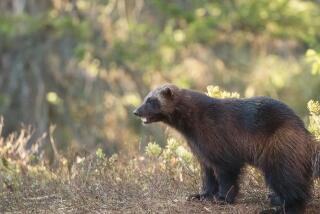Will the Wolf Survive? Yes, Biologists Find
YELLOWSTONE NATIONAL PARK, Wyo. — Field biologist Mike Phillips was fretting over the mysterious death of a young female wolf in a temporary holding pen here when the telephone rang.
It was a U.S. Fish and Wildlife Service official desperately wanting to ship at least five pups from a troublesome Montana pack to Phillips’ already overcrowded pens.
Phillips hung up the phone, sighed and said: “I can’t turn my back on those pups; the alternative is killing them. On the other hand, there may be a flaw in our husbandry program that could put other wolves at risk.”
It was another trying day in the office for the head of the historic project designed to bring wolves back to the top of the food chain in the nation’s oldest national park. He would rather have been out watching the effort unfold in the wild.
And unfolding it is. Twenty-one months after gray wolves from Canada were reintroduced to the northern Rocky Mountains of Yellowstone and central Idaho, they are settling in and breeding so successfully that biologists hope to begin the process of removing the wolf from the endangered species list by 2002.
With 34 wolves in five packs now loping through the forests, significant repercussions are being recorded throughout the 2.2-million-acre park’s wildlife hierarchy. Wolf predation, coupled with the sudden bounty of wolf-killed elk, is dramatically reshaping the behavior of scavengers, from grizzly bears to carrion beetles.
As a result, biologists say, life in Yellowstone is returning to a more natural state faster than anyone had anticipated.
*
“Over the past year, a wink in ecological terms, we’ve seen things we can scarcely believe,” said Robert Crabtree, a field biologist and federal consultant studying wolves and coyotes in the park. “Elk huddling in larger groups, grizzly bears fighting wolves, wolves killing coyotes and coyote pups, wolves forcing coyotes to den in places where they are running into black bears.”
The absence of the wolves had disrupted the natural balance of predator and prey throughout the Rocky Mountain region and resulted in a population explosion of such species as deer and elk. A fully recovered wolf population is expected to kill 1,200 elk, deer and moose a year.
Right now, Crabtree says, the greatest impact is being felt by coyotes, which were top dog in the park until the wolves returned.
“What was once a quiet, comfortable condominium complex for coyotes is now a totally socially disrupted system,” Crabtree said. “We’ve seen wolves kill coyotes with severe bites to the chest that crush ribs, play with the carcasses and then toss them aside unconsumed.
“At the risk of being anthropomorphic, I can’t help but be reminded of those ranchers who kill coyotes and hang them from fences to send a message to other coyotes.”
Trouble is, sheep also are being killed by wolves that roam beyond the park’s boundaries. When a wolf becomes a problem, it is captured and released elsewhere in the park, or killed. Nevertheless, ranching organizations are continuing legal efforts to dismantle the wolf program and have the animals that have been released so far returned to Canada.
*
“It’s a very sad thing to have your sheep eaten by wolves, and equally sad to have wolves shot to death on your property,” said Susan Brailsford, who lost four sheep to a lone Yellowstone wolf this year.
“The first time we lost sheep, the Feds . . . brought in a helicopter, netted the wolf, tranquilized it and then released it deep inside the park,” said Brailsford, whose family ranch is about 25 miles north of Yellowstone. About three weeks later, the wolf was back at her ranch, sniffing around the barn. Federal wildlife authorities killed the wolf with a shotgun fired from a helicopter.
Ranchers and their congressional allies once predicted that the wolves would kill hundreds of sheep and cattle. In fact, no livestock were killed in 1995. So far, Yellowstone wolves have killed only 12 sheep this year, and all affected ranchers have been compensated.
Losses of wolves also are lower than anticipated. Nine wolves have died in Yellowstone this year: Two adults and one pup were believed killed by other wolves, two were illegally killed, one was killed by federal wildlife authorities, one was hit by a delivery truck, a pregnant female died after falling into a hot spring and a female pup died of undetermined causes in a holding pen.
For biologists, those are acceptable losses.
“There is nothing simple about this restoration plan, but we are good at what we do,” Phillips said. “Also in our favor, wolves are good at what they do and hard-wired to breed.”
The prospects of watching wolves in action--and spectacular carnage--are drawing hordes of “wolf groupies” to northern Yellowstone’s lush Lamar Valley, a vast meadow between steep mountains where three packs are settling territorial scores.
The biggest rush in federal ranger Rick McIntyre’s 20 years of studying wolves came in June when he was standing on a roadside pullout in the valley with 100 people who had never seen a wild wolf before, all watching two packs battle over an elk carcass.
There were, he says, “Shakespearean dimensions” to that bloody encounter. A young male that charged an invading pack and pinned down its leader had, unknowingly, taken revenge on the very wolf that had killed his father in a fight a month earlier.
Peering through binoculars on a hill overlooking a confluence of rivers where the last Yellowstone wolves were killed in 1927, McIntyre said that “not since we put men on the moon have taxpayers been able to witness the success of a great federal initiative.
“In Yellowstone, they can get a spectacular view of their tax dollars at work, up close from the side of the road.”
As predicted, most of the wolves are settling in the general vicinity of their release sites in the northern portions of the park because that is where most of their prey lives. The cooperation of neighboring states and tolerance of their residents will determine the wolves’ ultimate range.
Before they were vanquished by government-backed poisoning and trapping campaigns, wolves thrived in nearly every region of North America north of Mexico City.
*
Once numbering in the hundreds of thousands, only about 2,100 wolves are left in the Lower 48 states and about 7,000 in Alaska, according to game officials.
With the wolf project under budget and ahead of schedule, biologists have forgone their original five-year plan to capture gray wolves from Canada annually and transport them here.
“By the end of this century, we will have about 80 to 100 wolves in the Yellowstone ecosystem,” Phillips said. “Complete recovery in the northern Rockies will come about when we have 10 packs in Yellowstone, northwestern Montana and central Idaho breeding simultaneously for three consecutive years.”
Once that happens, the wolves will no longer need their federal protection, and the financial burden of managing them will fall to Wyoming, Montana and Idaho.
The cost for the states is expected to be a fraction of the $6.7 million the federal government will spend shepherding the project through 2010, said Ed Bangs, the wolf recovery leader for Fish and Wildlife.
Phillips and a small army of volunteers continue the logistically demanding work of monitoring--on the ground and from the air--packs that roam 30 miles a night. They supply 3,000 pounds of meat each month to wolves in remote acclimation pens and relocate wolves to avoid conflicts on private land.
Phillips does not know what killed the captive young female wolf. But he did take in the five Montana pups--and five more that arrived a few days later.
“In a few years, we’ll be out of the confinement mode and doing research beyond letting wolves go. I’m looking forward to the day when we can let things sort themselves out in the wilds.”
More to Read
Sign up for Essential California
The most important California stories and recommendations in your inbox every morning.
You may occasionally receive promotional content from the Los Angeles Times.











